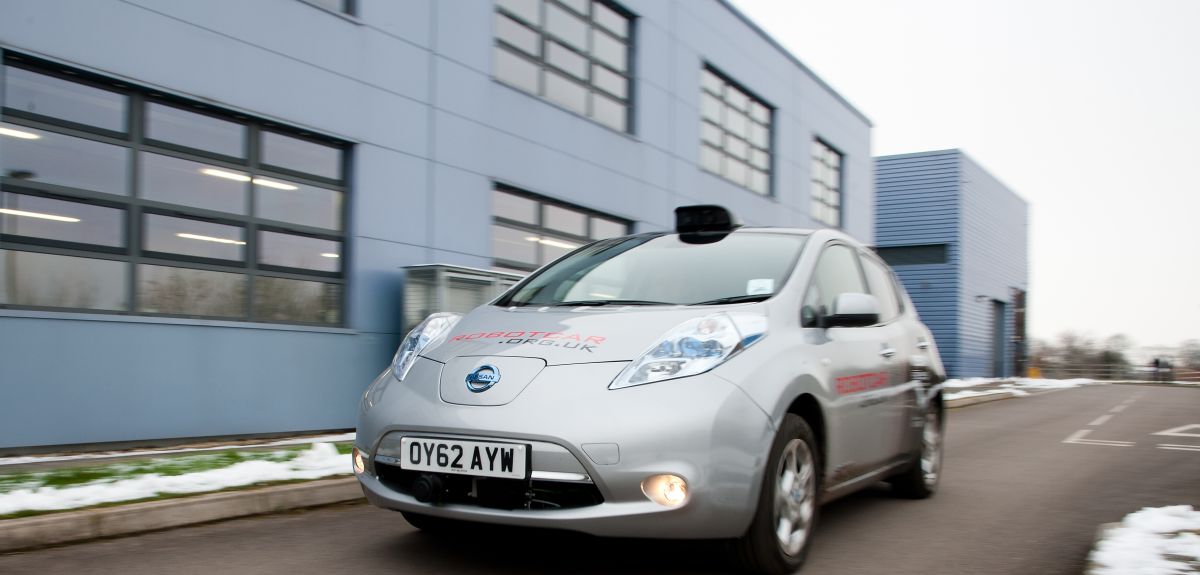
Robot electric car shows off iPad 'auto drive'
Robotic technology from Oxford University that enables a car to 'drive itself' for stretches of a route has been shown driving a Nissan Leaf electric car.
The work is a milestone on the way to creating everyday vehicles that can offer 'auto drive' for some parts of a journey, taking the strain off drivers during a busy commute or school run.
The low-cost navigation system can recognise its surroundings using small cameras and lasers discreetly built into the body of the adapted electric road car and linked to a computer in the boot.
The new car gives a glimpse of what the driver's experience of an auto drive-enabled car of the future might be like: the technology is controlled from an iPad on the dashboard that flashes up a prompt offering the driver the option of the car taking over for a portion of a familiar route – touching the screen then switches to 'auto drive' where the robotic system takes over. At any time a tap on the brake pedal will return control to the human driver.
'We are working on a low-cost "auto drive" navigation system, that doesn't depend on GPS, done with discreet sensors that are getting cheaper all the time. It's easy to imagine that this kind of technology could be in a car you could buy,' said Professor Paul Newman of Oxford University's Department of Engineering Science, an EPSRC Leadership Fellow who is leading the research alongside Oxford's Dr Ingmar Posner.
'Instead of imagining some cars driving themselves all of the time we should imagine a time when all cars can drive themselves some of the time,' said Professor Newman. 'The sort of very low cost, low footprint autonomy we are developing is what’s needed for everyday use.'
Some automated technology, for vehicles that 'park themselves' or react to changing road conditions, has already found its way into production road cars. Autonomous navigation systems, such as the one being developed at Oxford, are likely to be the next big step towards revolutionising the driving experience.
Whilst human drivers might use Global Positioning System (GPS) to find their way, such systems cannot provide anything like the coverage, precision, and reliability autonomous cars need to safely navigate, and, crucially, GPS fails to tell a robotic car anything about its surroundings.
'Our approach is made possible because of advances in 3D laser mapping that enable an affordable car-based robotic system to rapidly build up a detailed picture of its surroundings,' said Professor Newman. 'Because our cities don't change very quickly robotic vehicles will know and look out for familiar structures as they pass by so that they can ask a human driver "I know this route, do you want me to drive?" and the driver can choose to let the technology take over.'
At the moment it is estimated that the prototype navigation system costs around £5,000. 'Long-term, our goal is to produce a system costing around £100,' says Professor Newman.
The technology is currently being tested at its base at Begbroke Science Park, near Oxford. The next stage of the research, led by Dr Ingmar Posner, will involve enabling the new robotic system to understand complex traffic flows and make decisions on its own about which routes to take. Whilst there are many hurdles to overcome the long-term goal is to take such a system onto public roads.
'Whilst our technology won't be in a car showroom near you any time soon, and there’s lots more work to do, it shows the potential for this kind of affordable robotic system that could make our car journeys safer, more efficient, and more pleasant for drivers,' said Professor Newman.
The Oxford research is supported by the Engineering and Physical Sciences Research Council (EPSRC). The cars for the research, and support for them, are being provided by Nissan.
 Expert Comment: Chatbot-driven sexual abuse? The Grok case is just the tip of the iceberg
Expert Comment: Chatbot-driven sexual abuse? The Grok case is just the tip of the iceberg
 New study finds that stopping weight-loss drugs is linked to faster regain than ending diet programmes
New study finds that stopping weight-loss drugs is linked to faster regain than ending diet programmes